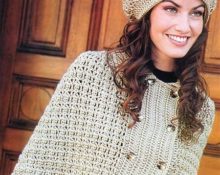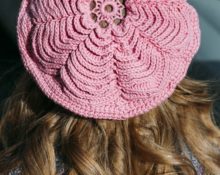A beret has always looked especially stylish and attractive on a girl’s head. And if it is knitted from cotton threads, then it may well become a wonderful addition to a summer ensemble. In the warm season, it does not easily complement the girl’s image, but also protects her head from the sun.

What do you need to crochet a summer beret?
Before you start knitting a beret, you should decide on the set of tools necessary for this creative process and, naturally, the type of future headdress. The first step is to choose yarn.

Yarn should be selected depending on the time of year, on which it is planned to knit a beret. It can be created for summer or winter, as well as for spring or autumn.
For a beret for the cold season, choose yarn with a high wool content. Thin threads and a large amount of cotton - this is suitable for summer. For all-weather options, you need to use mixed yarn. The choice of hook is secondary.
The only thing is that the hook in its thin part should be twice the thickness of the thread.
How to calculate time, materials and your efforts?
Knitting a beret is knitting in the round. It all starts from the center, and then we knit towards the center.
Knitting calculation for a beret
In order to knit a beret, we need to take the following measurements. We measure the girth of the head, the height from the forehead to the crown, and also take into account the peculiarities of the model, making adjustments for the wide part of the beret. The larger the increase, the more voluminous the finished product will be.
The figure shows how you can calculate the size of a beret using formulas by measuring the girth of the head (top line), and then calculate the radius of a small circle of the product (elastic band), as well as the optimal increase for a beret of a standard volume.

The amount of material required to make a beret depends on:
- product size;
- its pomp;
- features of the drawing.
It is logically clear that when knitting for a child, the thread consumption will be lower, and an openwork product will be more economical than knitting with a solid fabric.
For beginners, it is best to use knitting techniques in sections, like pizza slices, and then carefully assemble the project. This will make it easier not to get confused in the patterns. Even if you make a mistake, you won’t have to unravel the large fabric; it will be enough to bandage the unsuccessful wedge.
How to quickly crochet a beret for the summer?

Let's consider several schemes for making berets, which are suitable for both beginners and experienced knitters.
We knit an openwork headdress
In the summer heat, an openwork headdress not only looks charming, but also allows your head to breathe freely. There are many options for openwork, the choice depends on the experience and desire of the craftswoman.
Among the simple schemes you can choose the following:

And experienced craftswomen who want to create a unique product will like these options:


Whatever model you choose, you must remember 2 main rules:
- Always mark on the diagram or write down on a piece of paper where you stopped, even if you need to go away just for a short time. This way you can save your nerves and not rack your brains about what kind of loop it is now (row, column, pattern), and calmly continue knitting from where you left off.
- The number of threads should be 1–2 skeins higher than the number indicated in the diagrams. Sometimes the craftswoman lacks a small amount, or during the process the idea arises to knit something or decorate the beret. Often, in different batches of yarn that goes under the same article, there are half-tone differences in color.
Creative ideas for inspiration
The decoration of a crocheted beret depends on the style of its execution. If you want to decorate a monochromatic product, you can play with color using leftover threads from various products. In the same way you can emphasize the beauty of an openwork beret.

If after making the beret there is a little yarn left, then You can add additional pompoms, flowers, tassels to the product. Moreover, they can be either the same color or bright contrasting colors, enlivening a monochromatic design or complementing it.

When choosing threads of a different color to decorate the beret, you need to take into account that elements of contrasting colors look best. The most successful combinations:
- Red Black;
- black White;
- White blue;
- blue yellow;
- yellow green;
- orange - black.

In addition to decorating the beret using multi-colored or plain yarn, The trend today is summer hats decorated with colored satin ribbons, rhinestones, chains, lace and decorative braid. Often, thanks to the addition of such details, even a beret knitted with the simplest pattern acquires its unique appearance and becomes a real work of art.

When working on a beret, don't be afraid to experiment. Any creation that you make yourself will certainly make you stand out from the crowd and will be unique, inimitable and original.



 1
1





